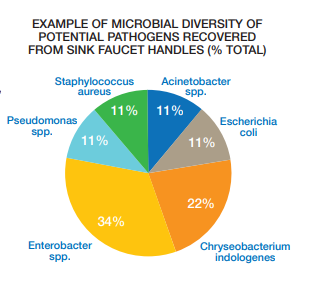_OPTIMIZED.jpg?width=661&name=pexels-photo-1722196%20(1)_OPTIMIZED.jpg)
According to the American Restroom Association 1 “A properly designed public toilet facility improves the experience of both those who operate the facilities and those who use them.
Proper design reduces queuing, misuse, and lowers initial and recurring cost.” A properly designed public restroom also minimizes hand contact and is easy to clean, thereby effectively preventing the spread of germs and improving the perception of cleanliness. Here are 14 things to consider when designing a restroom to prevent the spread of germs.
1. Install automatic flush valves on toilets and urinals
Sensor-operated flush valves, which are motion-activated, prevent users from touching flush handles, which could harbor bacteria and other germs. Not only do automatic flush valves work to prevent the spread of germs, they also are programmed to supply a predetermined quantity of water, thus reducing water consumption.
2. Install hooks on the backs of stall doors
It’s common for public restroom users to have their hands full with such items as coats, shopping bags, tote bags and purses. Providing adequate hooks on the backs of stall doors means these items can be hung, thus ensuring the items don’t become contaminated by having to be set on dirty and, potentially, wet floors.
3. Install enclosed toilet paper dispensers
Enclosed dispensers provide a barrier against moisture and germs, keeping the toilet paper virtually sterile. The enclosed dispenser itself harbors the germs that would otherwise be on the toilet paper, especially germs spread via the spray that’s created by flushing lidless toilets, so it’s important that dispensers be routinely cleaned and for restroom users to touch them as little as possible.
4. Install toilet seat covers
According to “What Can You Catch in Restrooms,”2 an article published by WebMD, toilet seats are not known for harboring germs: “… the toilet seat is not a common vehicle for transmitting infections to humans. Many disease-causing organisms can survive for only a short time on the surface of the seat, and for an infection to occur, the germs would have to be transferred … which is possible but very unlikely.” So it may seem at first glance that disposable toilet seat covers are more of an added expense than a necessity. However, consider this. Women often get toilet seats wet when squatting over them, so providing toilet seat covers encourages sitting, reducing the contamination that comes from squatting. Also, users who do prefer to sit often line toilet seats with toilet paper, so providing toilet seat covers reduces toilet paper waste.
5. Use touch-free faucets
Infection-causing germs are readily spread on high-touch surfaces, like faucet handles. According to an article titled “Cold and Flu Viruses: How Long Can They Live Outside the Body?”, published by Mayo Clinic, “Cold and flu virus-laden droplets may remain infectious for several hours, depending on where they fall. Viruses generally remain active longer on stainless steel, plastic and similar hard surfaces than on fabric and other soft surfaces.”3 The article adds that it is possible to catch an active virus after handling an object upon which an infected person recently coughed or sneezed.

Sensor-operated faucets, which are motion-activated, prevent users from coming into contact faucet handles, thereby eliminating one high-touch surface on which germs can be spread. In addition, touch-free faucets save water by both being set to run for a specific amount of time and eliminating the possibility of a faucet not being completely turned off.
6. Install deeper sinks with offset drains
Bacteria live in sink drainpipes, putting them in close proximity to restroom visitors. Researchers at the University of Virginia found that bacteria can colonize a sink’s P-trap in the form a biofilm that can actually climb up the drain. During faucet operation, the bacteria spread to surrounding areas via droplet dispersion.4
To prevent the spread of germs, install sinks that are designed to get water down the drain quickly with as little splashing as possible. Deeper sinks with offset drains are ideal, as they can help prevent contaminated water from splashing from within the drain, thereby keeping germs away from sink users.
7. Use touch-free soap dispensers
Sensor-operated soap dispensers, which are motion-activated, prevent users from spreading germs by eliminating the need to touch the surface. Choose one that dispenses foam, which rinses more easily than does liquid soap. Also choose one that has a window so that you can readily see when it’s time for a refill.
8. Use touch-free paper towel dispensers
When it comes to choosing between paper towel dispensers and air dryers, experts recommend paper towel dispensers. The reason is that air dryers might pull in bacteria from the air and spread them in the hand drying process. In fact, in a new study from researchers at the University of Connecticut and Quinnipiac University, plates containing sugar that were exposed to hot air from a bathroom hand dryer (approximately 12 inches from the nozzle) for 30 seconds in three different buildings grew an average of 18, 24 and 60 colonies of bacteria per plate in each building. This is as compared to plates containing sugar that were exposed to bathrooms in which hand dryers were turned off, which grew an average of six colonies of bacteria in 18 hours.6
Regarding paper towels, John Ross, MD, FIDSA, a contributing editor to Harvard Health Publishing’s Harvard Health Blog, indicates that “Paper towels are the most hygienic way to dry your hands. For this reason, use of paper towels is already routine in health care settings.”5 The experts at Handwashingforlife Institute take that a step farther, indicating “The friction added by using a paper towel is a significant part of the handwash.” They also note that, “The shorter the scrub step, the more important it is to use paper towels.” 7
Choosing sensor-operated paper towel dispensers, which are motion-activated, prevents users from spreading germs by eliminating the need to touch their surfaces. Enabling users to get their hands thoroughly dry means they’re avoiding moisture-loving bacteria.
9. Install shelves near handwashing stations
On one hand, it could be argued that installing shelves near handwashing stations is installing one more surface to which bacteria and viruses can attach themselves, thereby increasing the threat of contamination. There is truth to this, which we will come back to at the end of this section. On the other hand, shelves provide a place for restroom users to put their personal belongings without having to set them on a wet sink or dirty floor. In addition, users are able to complete a thorough hand wash because they’re not juggling their belongings in an attempt to avoid dropping them while simultaneously washing their hands. The key to preventing the spread of germs on shelves is to train staff to routinely sanitize them, just as they’re sanitizing the enclosed toilet paper dispensers.
10. Use touch-free waste receptacles
A person with clean hands should not have to touch a waste receptacle when disposing of used paper towels, so be sure to choose touch-free. There are a number of options, including flaps, and sensor and foot pedal activated. Place waste receptacles next to the exit door so that, when pushing the door open, a user can use paper towels as a barrier between his/her clean hands and the door, depositing the paper towels in the waste receptacle once the door is open. Bear in mind that, even if you use hand dryers, waste receptacles are still necessary to capture disposable items, such as diapers and feminine hygiene products.
11. Use no doors
People who have washed their hands run the risk of recontamination when they push open a restroom door to exit, based on the fact that people who haven’t washed their hands have pushed open the same door. Designing a restroom whereby users can exit without touching a surface reduces the spread of germs by minimizing hand contact, plus improves ventilation to discourage germ growth. A well-designed restroom with no doors has a vestibule entry preventing a direct line of sight to toilets, urinals or mirrors, thus protecting users’ privacy.
12. Install doors that push out
If your restrooms do or will have doors, hang them so that they swing out. This allows users to open doors with a push of a foot to the kickplate or the push of an elbow, eliminating hand-door contact and, therefore, effectively preventing the spread of germs.
| Also consider installing wall-mounted hand sanitizer on the wall next to the door so that, if hand-door contact is made, users can quickly and easily sanitize their hands as they exit. |
13. Make it easy to disinfect
When it comes to choosing floor, wall, and ceiling materials for public restrooms, the main consideration is that they be durable and impervious in order to facilitate cleaning. Restroom Association (Singapore)8 recommends the following:
|
Speaking of ceramic floor tiles, American Restroom Association 1 advocates curved tiles, as opposed to a 90-degree edge, in corners between the floor and wall to “prevent dirt build-up and facilitate cleaning.”
Choosing impervious finishes means that finishes that harbor moisture, such as paint on walls and wood on floors, are avoided, which is a good thing because moisture is a breeding ground for bacteria.
Finally, Restroom Association (Singapore)8 recommends rigid partitions that are wall or ceiling hung and without leg support to ensure that the floor is easy to clean.
14. Install an effective ventilation system
According to American Restroom Association 1, “Well ventilated restrooms can significantly reduce the sense that a restroom is dirty. Ventilation also protects occupants from the misapplication of dangerous commercial cleaning products.” An effective ventilation system does more than give the appearance of clean restrooms—it works to keep restrooms dry, thereby preventing mold growth on floors and walls.
Designing public restrooms to prevent the spread of germs is not a difficult challenge, but it is a challenge that requires careful consideration of every surface in order to minimize hand contact and ensure easy cleanability.
References
- American Restroom Association. (n.d.). Public restroom design issues. Retrieved February 11, 2019, from https://americanrestroom.org/public-restroom-design-issues/
- WebMD. (2002). What can you catch in restrooms? Retrieved February 8, 2019, from https://www.webmd.com/balance/features/what-can-you-catch-in-restrooms#1
- Steckelberg, J.M. (n.d.). Cold and flu viruses: How long can they live outside the body? Retrieved February 18, 2019, from https://www.mayoclinic.org/diseases-conditions/flu/expert-answers/infectious-disease/faq-20057907
- Kotay, S., Chai, W., Guilford, W., Barry, K., & Mathers, A.M. (April 2017). Spread from the sink to the patient: In situ study using green fluorescent protein (GFP)-expressing Escherichia coli to model bacterial dispersion from hand-washing sink-trap reservoirs. Applied and Environmental Microbiology, (83)8, 1-12. Retrieved February 18, 2019, from https://aem.asm.org/content/aem/83/8/e03327-16.full.pdf
- Ross, J. (May 11, 2018). The bacterial horror of hot-air hand dryers. Retrieved February 18, 2019, from https://www.health.harvard.edu/blog/the-bacterial-horror-of-the-hot-air-hand-dryer-2018051113823
- Huesca-Espitia, LDC, Aslanzadeh, J, Feinn, R., Joseph, G, Murray, T.S., & Setlow, P. (April 2018). Deposition of bacteria and bacterial spores by bathroom hot-air hand dryers. Applied and Environmental Microbiology, (84)8, 1-11. Retrieved February 18, 2019, from https://aem.asm.org/content/aem/84/8/e00044-18.full.pdf
- Handwashingforlife (April 2, 2011). Air dryers fail critical hand hygiene tests. Retrieved February 18, 2019, from http://handwashingforlife.com/blog/jim-mann/air-dryers-fail-critical-hand-hygiene-tests
- Restroom Association (Singapore). (2018). A guide to better public toilet design and maintenance, fourth edition. Retrieved February 8, 2019, from https://www.toilet.org.sg/articles/GuideBetterPublicToilet.pdf
.png)


